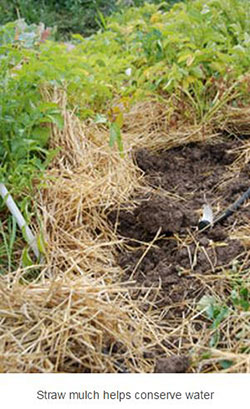Adapted from the CO-Horts blog originally authored by Carol O’Meara, Boulder County Extension
Build your soil’s moisture holding capacity by amending the soil with organic material, such as compost. This breaks up clay, providing better growing conditions for roots during times of stress.
Make a commitment to drip or trickle irrigation. Sure, a gently oscillating fan of water is festive to watch, but in a dry land, irrigating by throwing water through the air is wasteful. Drip reduces water usage by about 50 percent, and soaker hoses are inexpensive and easy to use. Known as a “leaky pipe,” soaker hoses let water seep out all along its length at a slow rate. Emitter type hoses, with small disks that seep, are good on individual plants, such as peppers, but not as efficient with leafy row crops, like lettuce, which need uniform coverage all along the row.

Mulching is crucial for conserving water. Research has shown that one to three inches of organic mulch lowers water needs by reducing evaporation of moisture from the soil. Weeds are less of a problem too, which leaves more water available for the vegetables. Dried grass clippings or straw are ideal; wait until soil has warmed before applying the mulch, usually in mid-June. Plastic mulch is only recommended for tomatoes, peppers, eggplants, and vining crops such as squash or cucumbers. Place mulch over water hoses for best water conservation.
Choosing plants that withstand hot, dry conditions greatly help in getting good production. Many varieties are available that resist bolting (when the plant stops growing edible leaves and rapidly produces non-edible flowers).
Plant in blocks, rather than rows; you’ll increase yields five-fold. Block planting is a compact design in which vegetables are grown in smaller, square plantings instead of stretching them out in long rows. As the plants grow, their leaves fill in and shade roots, conserving water in the soil underneath. Plan on blocks that are three to four feet wide and any desired length.
Group plants with similar water needs together on the same soaker hose. Cucumber and zucchinis, for example, require similar amounts of water. Water is needed during the first few weeks of development, immediately after transplant, and during formation of edible plant parts.
Apply water at low pressure for only 10 to 15 minutes. Much faster than this causes run-off, unless the soil has exceptionally good drainage. Water during early morning, when wind is low and temperatures are cool. Use a timer for the watering and time it to deliver only what is needed by the plants, avoiding watering during rainfall. Watering restrictions that limit irrigation to every two or three days should not have a major impact on the vegetable garden.
Provide wind breaks and shade to reduce evaporation of moisture from soil. Wind can wick water from the soil and from plant surfaces. High heat and direct sun take their toll on even the most sun loving plants if water is reduced. Tomatoes, for example, will not set fruit in high temperatures and peas, lettuces, and broccolis will bolt. Shade can be provided with the use of shade barrier cloth that will cut sunlight by approximately 25 percent. Gardeners should construct a shade canopy over plants before the high heat of the summer arrives and place the cloth over heat sensitive plants when temperatures soar into the upper 80’s.



